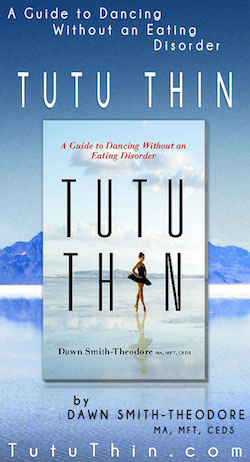We’ve seen it portrayed in movies, in literature, in art and in theater – the dancer who’s obsessed with her weight. Whether in secret or in public, many of us dancers have argued against this stereotype, contending that it supports a negative cultural view of dance, while simultaneously identifying with it on a personal level. It’s an inner conflict that each dancer has felt.
Why is that? Perhaps it’s because we seriously dislike that our life-giving art form is being categorized and stereotyped in such a way that casts it as life-robbing. But perhaps the duality comes because we also know that it’s true – dance does see a higher proportion of participants affected by unhealthy self-image. As a matter of a fact, as dancers, we’re three times more likely to know someone who’s battled an eating disorder, according to a meta-analysis of 33 studies released between 1966 and 2013.
It’s clear then that eating disorders are a real problem in the dance industry. It’s a tragic, unfortunate fact. For that reason, Dance Informa recently connected with Dawn Theodore, a leader in the treatment of eating disorders.
Theodore, a former professional dancer and current studio owner, battled an eating disorder for over a decade. She brings her personal experience with anorexia nervosa and her knowledge of dance to her book, Tutu Thin: A Guide to Dancing Without an Eating Disorder. The book seeks to help dancers, dance teachers and parents understand how an eating disorder can take over and how to prevent it from doing so.
 Carolyn Costin, chief clinical officer at Monte Nido and Affiliates, a treatment center program where Theodore also works, wrote the foreword for Tutu Thin. In her concluding remarks, Costin said, “Dawn’s extensive training and personal experience lend the book credibility that only someone who has ‘been there and done that’ can give… Readers will get specific advice and information on finding the balance between life and dance, nutrition tips and even treatment options.”
Carolyn Costin, chief clinical officer at Monte Nido and Affiliates, a treatment center program where Theodore also works, wrote the foreword for Tutu Thin. In her concluding remarks, Costin said, “Dawn’s extensive training and personal experience lend the book credibility that only someone who has ‘been there and done that’ can give… Readers will get specific advice and information on finding the balance between life and dance, nutrition tips and even treatment options.”
Based on Theodore’s book, here are tips on how to prevent the thinking and behavior that leads to an eating disorder:
#1. Know the reasons dancers are more likely to develop an eating disorder. According to data and personal testimonies, eating disorders are more likely to start when a dancer has one or more of the following: a tendency to be a perfectionist, a traumatic life event happen, an obsession with social media and a constant habit of comparison, family communication issues, a mood disorder (high levels of anxiety or a struggle with depression), or being involved in an organization or group that places high importance on physical appearance. DNA is a factor, too, as there is a genetic linkage on chromosome 1. The eighth reason might be the most obvious – a fixation on dieting.
If you or someone you know identities with these, be vigilant. That person is vulnerable and statistically more likely to struggle with an eating disorder.
#2. Choose positivity and encouragement. Theodore opens her second chapter in Tutu Thin by explaining, “When you suffer from an eating disorder, you live with the mantra ‘never enough’. Whether it’s the number on the scale that could always be lower, or feeling as though you can never get enough food when binging, or believing you can never exercise enough, the concept remains a familiar thread in the life of someone who suffers from an eating disorder.”
This idea of never being good enough is especially constant in the mind of a perfectionist – a title that many dancers proudly claim when asked. The problem is that your mind is then being filled with criticism and spite instead of self-confidence and support. This is especially dangerous when it’s being echoed in a public sphere as well, whether through well-meaning teachers saying comments that are misconstrued or actual bullies who are purposefully pointing fingers and mocking others. Cyber-bullying is at an all time high in this generation, so parents should be especially careful how they let their dancers engage online.
While dancers can’t always battle the negative voices hammering them in the public sphere, they can choose to better filter their own thoughts and attitudes. Are you acknowledging all that you and others do well? Are you thankful for what you and your friends do have? Are you grateful for what you and they are able to accomplish? Are you offering yourself the same grace and patience that you offer to those you love? When was the last time you encouraged yourself?
#3. Realize that balance is key. One reason an eating disorder begins is because a person has lost proper perspective. And how do you keep perspective? Simply put: by maintaining a healthy balance.
Theodore writes about the importance of rest in an industry that often seems to reject the idea. She states, “Dancers can work to stop embracing the fearful thought that if they don’t take an extra class or go away to every summer intensive, they won’t find success in the dance world. Taking a break once in a while can give your body a rest and allow the time to enjoy relationships in your life.”
It’s only when properly rested and given a little distance that dancers can fully reflect on everything. This downtime is crucial for remembering why you love dance in the first place and what is true.
Adding to this, Theodore writes that other important ingredients in the recipe for balance are “self-confidence, trust in self, support from loved ones, health, ability to communicate and the nurturing of relationships.”
#4. Beware strict rules, rigidity and rituals. These can often be symptoms of an eating disorder: having rules on how much they can eat or how many calories they can intake, refusing to eat something that wasn’t planned for, and exhibiting strange rituals like cutting up food into tiny pieces or hiding uneaten meals.
#5. Place value on health and nutrition, not appearance. Here’s the truth: all bodies are inherently different and, therefore, everyone’s body is singularly distinct. At the end of the day, these vessels we all live our lives in are beautiful gifts, and instead of treating them with contempt or rigid formulas, we each need to appreciate their uniqueness and choose to approach them with respect and curiosity.
Theodore addresses this in her fifth chapter, saying, “It is important as a dancer to focus on your own needs and not compare yourself to your friends, parents or family members who eat differently or not as much as you do.”
She goes on to lay out what a healthy meal plan for dancers should entail – from bone-building nutrients like calcium to protein. She even shares some healthy breakfast, lunch and dinner recipes, and satisfying snack options. Instead of dieting, Theodore recommends nutrition education and beginning a journey of healthy self-discovery.
To learn more about Dawn Theodore or her book Tutu Thin, head to www.tututhin.com.
By Chelsea Thomas of Dance Informa.















